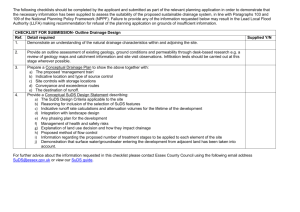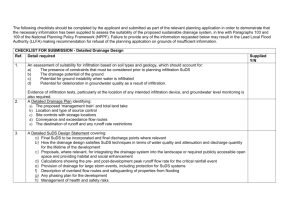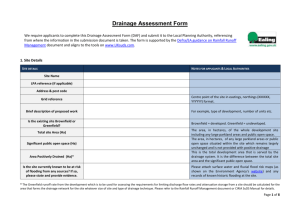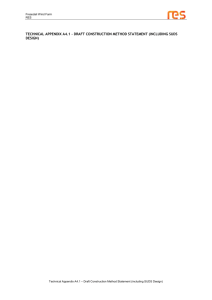Sustainable Drainage Systems (SUDS)
advertisement
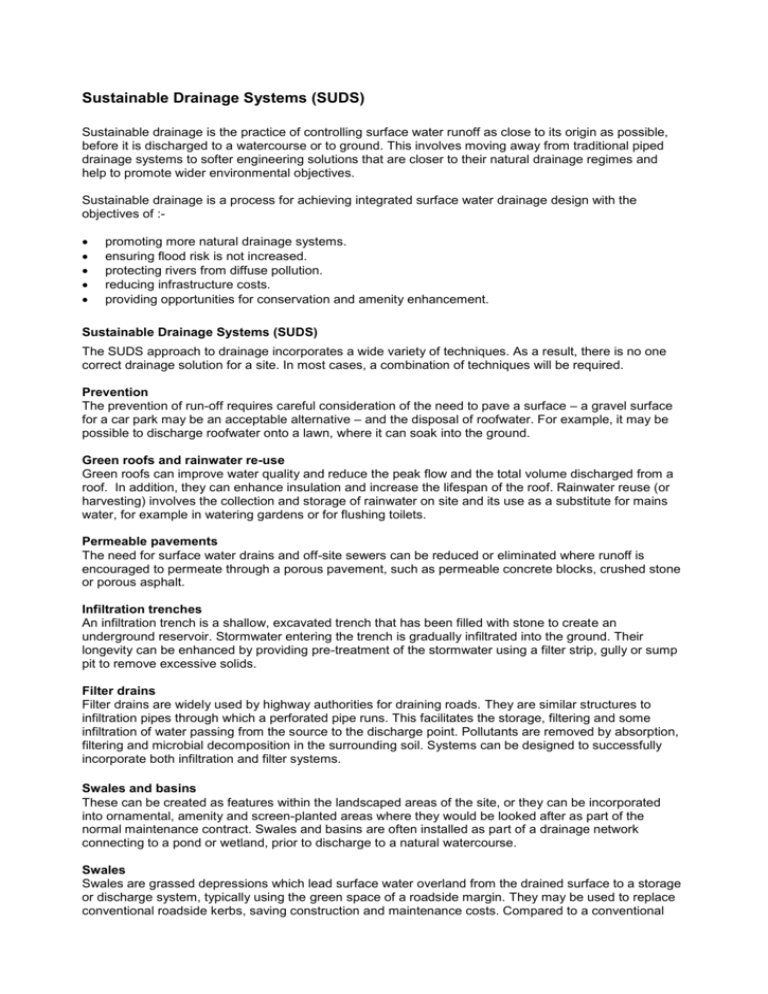
Sustainable Drainage Systems (SUDS) Sustainable drainage is the practice of controlling surface water runoff as close to its origin as possible, before it is discharged to a watercourse or to ground. This involves moving away from traditional piped drainage systems to softer engineering solutions that are closer to their natural drainage regimes and help to promote wider environmental objectives. Sustainable drainage is a process for achieving integrated surface water drainage design with the objectives of : promoting more natural drainage systems. ensuring flood risk is not increased. protecting rivers from diffuse pollution. reducing infrastructure costs. providing opportunities for conservation and amenity enhancement. Sustainable Drainage Systems (SUDS) The SUDS approach to drainage incorporates a wide variety of techniques. As a result, there is no one correct drainage solution for a site. In most cases, a combination of techniques will be required. Prevention The prevention of run-off requires careful consideration of the need to pave a surface – a gravel surface for a car park may be an acceptable alternative – and the disposal of roofwater. For example, it may be possible to discharge roofwater onto a lawn, where it can soak into the ground. Green roofs and rainwater re-use Green roofs can improve water quality and reduce the peak flow and the total volume discharged from a roof. In addition, they can enhance insulation and increase the lifespan of the roof. Rainwater reuse (or harvesting) involves the collection and storage of rainwater on site and its use as a substitute for mains water, for example in watering gardens or for flushing toilets. Permeable pavements The need for surface water drains and off-site sewers can be reduced or eliminated where runoff is encouraged to permeate through a porous pavement, such as permeable concrete blocks, crushed stone or porous asphalt. Infiltration trenches An infiltration trench is a shallow, excavated trench that has been filled with stone to create an underground reservoir. Stormwater entering the trench is gradually infiltrated into the ground. Their longevity can be enhanced by providing pre-treatment of the stormwater using a filter strip, gully or sump pit to remove excessive solids. Filter drains Filter drains are widely used by highway authorities for draining roads. They are similar structures to infiltration pipes through which a perforated pipe runs. This facilitates the storage, filtering and some infiltration of water passing from the source to the discharge point. Pollutants are removed by absorption, filtering and microbial decomposition in the surrounding soil. Systems can be designed to successfully incorporate both infiltration and filter systems. Swales and basins These can be created as features within the landscaped areas of the site, or they can be incorporated into ornamental, amenity and screen-planted areas where they would be looked after as part of the normal maintenance contract. Swales and basins are often installed as part of a drainage network connecting to a pond or wetland, prior to discharge to a natural watercourse. Swales Swales are grassed depressions which lead surface water overland from the drained surface to a storage or discharge system, typically using the green space of a roadside margin. They may be used to replace conventional roadside kerbs, saving construction and maintenance costs. Compared to a conventional ditch, a swale is shallow and relatively wide, providing temporary storage, conveyance, treatment and the possibility of infiltration under suitable conditions. Basins A basin is designed to hold back storm runoff for a few hours and to allow the settlement of solids. They are dry outside of storm periods. They provide temporary storage for storm water, reduce peak flows to receiving waters, facilitate the filtration of pollutants (deposited and incorporated into the substrate) and encourage microbial decomposition, as well as allowing water infiltration directly into the ground. Example © Geoff Gibbs, Environment Agency. The Bramley Green development is located in Angmering, West Sussex and consists of a mixed residential development of some 600 units. Sustainable drainage for the site includes a new pond (foreground), a flood storage area and an under-drained infiltration area within a public open space. (Adapted from Environment Agency website, 2007)


